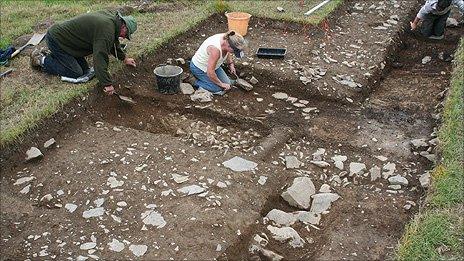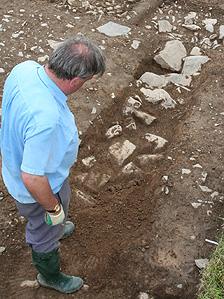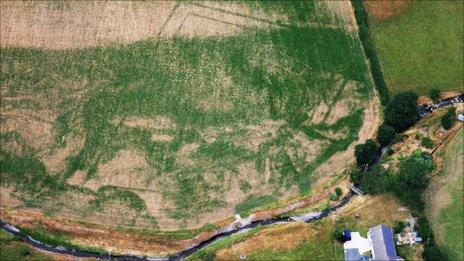Remains of Roman villa near Aberystwyth discovered
- Published

Archaeologists dig showing the excavated walls of the villa
Archaeologists have discovered a 4th Century Roman villa near Aberystwyth.
It is the most north-westerly villa found in Wales and has forced experts to reconsider the whole nature of Roman settlement across mid and north Wales.
Findings indicate Abermagwr had all the trappings of villas found further south, including a slate roof and glazed windows.
"The discovery raises significant new questions," said Dr Toby Driver and Dr Jeffrey Davies, excavation directors.

The 2010 excavation confirmed the villa, after its likely origins were first spotted in 2006
The villa is likely to have belonged to a wealthy landowner, with pottery and coin finds on the site indicating occupation in the late 3rd and early 4th Centuries AD.
It was roofed with local slates, which were cut for a pentagonal roof. The walls were built of local stone and there was a cobbled yard.
The confirmation of the villa comes after Royal Commission aerial photography during the drought of 2006 suggested marks of a building and a ditch which could be an important historical monument.
Dr Driver and Dr Davies, while filming for BBC2 Wales' Hidden Histories programme in 2009 conducted a geophysical survey of the field. It revealed a vast ditched enclosure and annex, as well the buried footings of a winged stone building.
This led to the 2010 excavations.
Dr Driver, of the Royal Commission on the Ancient and Historical Monuments of Wales and Dr Davies, formerly of Aberystwyth University, had previously excavated at the nearby Trawscoed Roman fort, which had been abandoned by AD 130.
"Our trial excavations this year have confirmed the remains of an imposing Romano-British building in the heart of mid-Wales, where no Roman villas were previously known" they said.
"Here we have a later Roman building where the owners were importing pottery, using coinage, and insisting on decorative slate roofing akin to the largest Roman villas in England.
"The discovery raises significant new questions about the regional economy and society in late Roman Wales, and raises the possibility of future villa discoveries in the surrounding countryside".
The villa was heavily robbed for its building stone, probably in medieval times.
'Robber trenches' were dug into the ruins and the most useful blocks removed, leaving just the clay and stone packed foundations.
The land returned to farming and only the local name 'Magwr', meaning a "ruined homestead" preserves any memory of a building.
The excavation was supported by local landowner Huw Tudor and the site has already been visited by three local schools and a young archaeologists club.
Some of the finds will be displayed in the Ceredigion Museum, Aberystwyth.

The outline of the Roman villa, spotted from the air